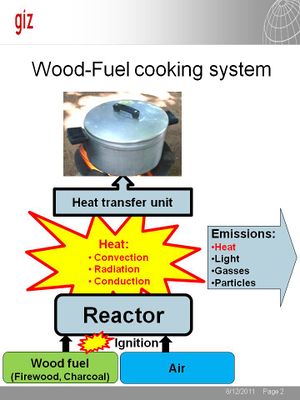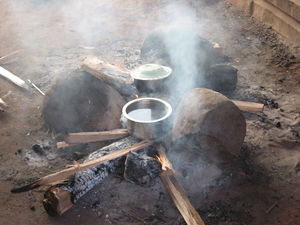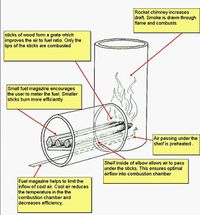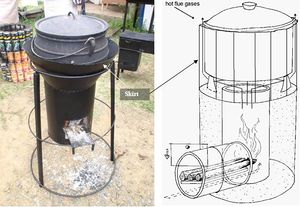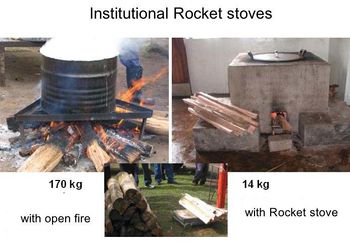Knowledge fuels change
For over a decade, Energypedia has shared free, reliable energy expertise with the world.
We’re now facing a serious funding gap.
Help keep this platform alive — your donation, big or small, truly matters!
Thank you for your support
Firewood Cookstoves
Cooking Energy System | Basics | Policy Advice | Planning | Designing and Implementing ICS Supply | Designing and Implementing Woodfuel Supply | Climate Change | Extra
Introduction
Firewood is wood from logs, sticks or twigs. It has been used as a fuel since the beginning of mankind. In principle, it is renewable and relatively easy to produce, transport and store. However, the use of firewood for cooking is commonly associated with deforestation and health problems. This is not an inherent problem of the fuel, but is strongly influenced by the quality and quantity of its correct usage and can be overcome by improving the efficiency of the wood fuel usage.
Two major factors determine if firewood burns clean and efficient: its moisture content and the oxygen supply of the fire. While it depends on the user to make sure that the fuel is dry, the air-flow depends on the stove design. In a natural draught stove, the supply of air is created by the chimney or stack height of the fuel. However, there must be a difference in temperature between the stove and the top of the chimney to generate draught. Natural draught is likely to cause incomplete combustion with higher emissions and energy losses through the chimney. Moreover, it is also difficult to regulate.
The burning of wood is a sequence of steps:
- Moisture is evaporated
- Wood decomposes into combustible wood-gas and char
- Char is converted into ash
The main influencing agent for “a)” and “b)” is heat, whereas “c)” is regulated by the supply of oxygen.
Find here more information and illustrating figures on pages 14-15 in the "Manual on Micro-gasification". For more information on the characteristics of firewood as a fuel see Cooking with Firewood.
The Wood-Fuel Cooking System
As shown in the figure beside, in the wood-fuel cooking system, firewood is mixed with air in a reactor. After ignition, a chain reaction is triggered in which heat is generated. This heat is transferred through 3 processes:
Convection: Hot gasses are passing a surface transferring heat into surrounding materials;
Radiation: Red hot embers is radiating heat into surrounding materials;
Conduction: Heat is conducted through materials. Metal is a good heat conductor, whereas air is a poor heat conductor.
The reactor is emitting heat, but also light, gasses and particles. While the emission of heat is wanted, the emission of gasses, particles and light are rather unintended. Good stove designs can reduce the quantity of unwanted emissions in favor of additional heat generation. The heat does not enter automatically into a cooking pot. The design of the heat transfer unit has a big effect on the percentage of the heat transferred into the food to be cooked.
Overall there are two major dimensions for efficiency gains for firewood stoves:
- Achieve complete combustion (=‘create more heat per unit of fuel used’)
- Improve heat transfer (=‘get more heat actually into the pot’)
Three-stone Fires or Open Fires
Worldwide, millions of people cook on so-called 3-stone fires or open fires as this is the simplest and cheapest “stove” to create. Only three suitable stones of the same height are needed to balance a pot over a fire. However, the daily use of these 3-stone fires has the following disadvantages:
High fuel consumption:
The open fire consumes a lot of fuel as
- (a) not much heat is generated per unit of fuel,
- (b) only a small proportion of the heat is actually directed to the pot and
- (c) only a small fraction of the heat that is directed to the pot is actually transferred into the food.
- Slow pace of cooking:
The cooking pot does not sit in the hottest part of the flames; hence less heat is transferred to the pot than theoretically possible. Even if a lot of heat is generated, the heat is not directed to the cooking pot and heat is lost to the environment. This problem is accelerated if there are windy conditions as the flames are not shielded. - Smoke:
The combustion in an open fire tends to be incomplete as oxygen might not reach where it is needed. Low temperatures also contribute to the emission of smoke (= unburned particles). - Health risks:
As the flames are not directed or shielded, the cook can easily catch fire when approaching the cooking pot. Sparks pose an additional risk when approaching the fire. Burns are a common effect of open fires. The smoke might also cause eye infections.
On the other hand, users welcome some of these inefficiencies due to their positive side effects:
- Open fires burn slow and do not require frequent attention. This is convenient if other household chores have to be done at the same time.
- Smoke can chase away mosquitoes, which is especially beneficial in malaria-infested areas;
- Smoke can be used to preserve food;
- Open flames emit light, which is welcome before sunrise or after sunset;
- Open fires emit heat, which is favorable in cold areas.
Three-stone Fire versus Improved Cookstove
The development of improved cookstoves is facing a dilemma: the same characteristics are at the same time responsible for both users’ complaints and appreciations of the 3-stone fire. There is no solution which can satisfy all expectations. Any new stove will be a trade-off between different user needs. This dilemma is summarized in the table below. Furthermore, users are used to a specific cooking system and any change in cooking habits needs time.
| Common changes of parameters in improved cook stoves | Common expectations towards improved stoves | "Disadvantages” for associated benefits of open fires |
|
Improve efficiency of heat production
|
|
|
|
|
|
Households have to prioritize their needs in order to come up with the decision if an improved cook stove is suitable for them. In areas with fuel scarcity, the need for reduced fuel consumption might be ranked higher than the need for space heating or lighting after dark.
A strategy can be to provide additional solutions to complement the introduction of the improved cook stoves:
- an extra space heater for the cold season
- a mosquito-repellent net
- a solar lantern for lighting
Design Principles for Improved Cookstoves
All improved firewood stoves apply at least some of the aspects listed below geared toward increasing efficiency and improving heat transfer.[1]
How can we improve the design of the stove to increase the combustion efficiency in a firewood stove?
| Aspect |
How to achieve |
|---|---|
| Increasing the temperature in the combustion chamber (as the burning process is temperature controlled) |
|
| Reduce the intake of firewood |
|
| Burn off all the volatiles |
|
| Adequate air supply |
|
| Reduce the inflow of cold air |
|
| Intake of pre-heated air |
|
| Increasing the draft |
|
| Increase the surface of the wood that is in contact with air |
|
How can we improve the design of the stove to improve the heat transfer in a firewood stove?
| Aspect |
How to Achieve |
|---|---|
| Raise the pot to the highest point of the flames |
|
| Force the hot air to create turbulences on the surface of the cooking pot |
|
| Increase the surface area for the heat transfer |
|
| Make sure that the heat is going into the pot instead of going into the stove body |
|
The Rocket Stove Principle
One of the most successful concepts in stove design is the rocket stove principle, invented by Dr. Larry Winiarsky. Rocket stoves’ characteristics are:[2]
- An elbow-shaped combustion chamber (1:1.5) with a shelf for the fuel wood, which supports the pre-drying of the firewood and allows a controlled, and sufficient, flow of primary air to be warmed as it passes under the wood to the burning wood tips.
- The tall combustion chamber behaves a bit like a chimney, creating more draught than a standard stove. This assists in mixing the air, fuel particles and volatiles, resulting in a hot flame.
- The internal walls are insulated, reflecting all the heat back into the chamber rather than losing it to the stove body. The insulation keeps everything very hot so that the chemical reaction is more intense, whilst the tall chamber provides more time in which the gases and particles can be burnt completely, emitting all their heat and discharging mainly carbon dioxide and water vapor.
- These hot flue gases pass through a well-defined gap between a ‘skirt’, and the pot, resulting in a large percentage of the heat being forced against the sides of the pot, and being transferred to the pot. Where various sizes of pot are used on the same stove, the skirt can be funnel-shaped to accommodate different pots, although some efficiency will be lost.
Today, most of the GIZ-promoted wood stoves follow this rocket stove principle (see fact sheets below for examples). Besides household stoves also stoves for institutional or productive purposes can incorporate the rocket stove principle. For example in Malawi, the considerable savings have made institutional rocket stoves very popular among school feeding programs (see also Ashden Award video 2006).
Wood Fuel Stoves with Forced Convection
Instead of naturally ‘pulling’ air through a stove by stack height, fans or blowers are useful to ‘push’ air into the combustion chamber. This enhances a good air-fuel mix and thus, more complete combustion. Electricity is the most convenient power source to create a forced air-flow. It can be provided by batteries or, if available, through the grid. Forced convection can reduce emissions of stoves by up to 90 %, thus alleviating Indoor Air Pollution (IAP) levels. See also the article onMicro-Gasifier Cookstoves. Recently, thermo-electric generators (TEG) have been developed to power fans in stoves. They use the temperature differences within the stove to generate electricity, thus eliminating the need for external power supply. TEGs also have great potential to provide power to other applications, such as LEDs or mobile phones. However, the unit makes a stove more expensive and can be destroyed easily, when getting too hot. Pico PV units could also easily provide that little electricity needed for mobile charging without burning firewood.
Stove Factsheets and Manuals
The stove factsheets are a series of technical information sheets on different stoves promoted by GIZ. Wherever available, additional information such as construction manuals and user guidelines for the respective stoves is also provided.
Fixed Stoves
- MIRT stove for injeera baking, Ethiopia; Training Manual Mirt Stove in Amharic[LF2] (2011) and User Guideline page 1 andpage 2in Amharic.
- Jiko Kisasa, Kenya (2011)
- Brick Rocket Stove, Kenya (2011); and Rocket Brick Stove: Builder’s Manual & User’s Guide
- Two pot mud-rocket Lorena with Air Bypass, Uganda (2011); and Construction manual for household stoves. Guide from 2008 featuring air-bypass. --> Available also in French
- Two pot mud-rocket Lorena with shelf, Uganda (2012)
- Fixed One-Pot Rocket Mud Stove, Benin, Uganda (2011)
- Esperanza stove, Malawi
- Malawi Institutional Brick Rocket Stove, Malawi (2008)
- Inkawasi Stoves in Peru (various models adapted for different regions and materials) (2011):
- Inkawasi UK for firewood and dungInkawasi Tawa
- Inkawasi Tres Hornillas
- Inkawasi Pichqa
- Inkawasi Sujta
- Inkawasi Plancha de Fierro
- Manual Uso y Mantenimiento de la Eco-Estufa Justa, Honduras (2011)
- Manual Construyendo la Eco-Estufa Justa 16 x 24, Honduras (2011)
Portable Stoves
- One-Pot Shielded Fire Stove with shelf, Uganda (2012)
- One-Pot Shielded Fire Stove with bypass air inlet, Uganda (2011)
- Tikikil, Ethiopia 2012; Production Manual (English); Production Manual (Amharic), User guideline (English), User guideline (Amharic)
- Institutional Rocket Stove (IRS) Ethiopia (2012), Production manual, User guideline
- Jambar Stove Firewood, Benin, Kenya, Senegal (2011)
- Tulipe-Céramique, Benin, Burkina Faso (2011)
- Burkina Mixte, Burkina Faso (2011). Stove for firewood and charcoal.
- Ouaga Métallique, Burkina Faso (2011)
- Multimarmite Stove, Burkina Faso (2011). Stove for firewood and charcoal.
- Sakkanal, Senegal (2011). Stove for firewood and charcoal.
- Chitetezo Mbaula, Malawi (2008)
- Institutional Metal Rocket Stove, Malawi (2008)
- Inkawasi portatil, Peru (2011)
Further Information
- Classification of Cookstoves
- Cooking with Firewood, article on energypedia
- Energy-Saving Cooking Equipment
- Improved Cooking Portal on energypedia
- Aprovecho Research Center
For almost 30 years, Aprovecho Research Center (ARC) consultants have been designing and implementing improved biomass cooking and heating technologies in more than 60 countries worldwide. Their website provides a wealth of useful information including construction materials.- Design Principles for Wood Burning Cook Stoves, by Aprovecho Research Center (2005).
- 10 Design Principles for Wood Burning Stoves (Poster), by Aprovecho Research Center (2005).
- Design Tool for Constructing an Institutional Rocket Stove with Chimney
With funding from GIZ HERA, Rocket Stove.org and Prakti Design Lab have developed a new automated tool that allows users to build a customized institutional rocket stove. The tool can be used to design a brick or metal institutional rocket stove with or without chimney for any institutional pot (30 L + capacity).
Depending on the availability of construction materials, components and production options, three stove options are available for this tool:- a fixed brick stove (w/out chimney)
- a portable metal stove with square combustion chamber (w/out chimney)
- a portable metal stove with circular combustion chamber (with chimney)
- Rocket Stove Principle
An animation showing the rocket stove principle. - Efficient, smoke-free cooking with the Rocket Stove. Poster (2007)
- Online Catalogue of Clean Cookstoves. Compiled by the global Alliance for Clean Cookstove and its partners.
- Stove Models Developed by other organizations and companies
- Stove Images - a Documentation of Improved and Traditional Stoves in Africa, Asia and Latin America. By Beatrix Westhoff and Dorsi German (1995). It is available in English, French and Spanish. The publication provides a very comprehensive overview on global stove diversity.
- UNESCO (1982): Consolidation of Information. Cooking Stoves Handbook
- Changing Climate Change: Solutions. BBC Documentary on portable ceramic cookstoves in Malawi used with a TEG.
References
This article was originally published by GIZ HERA. It is basically based on experiences, lessons learned and information gathered by GIZ cook stove projects. You can find more information about the authors and experts of the original “Cooking Energy Compendium” in the Imprint.
- ↑ Aprovecho Research Center (2005): Design Principles for Wood Burning Cook Stoves. http://www.ewb-usa.org/files/2015/05/PrinciplesWoodBurningCookStoves.pdf
- ↑ http://www.ashden.org/files/Aprovecho2006.pdf
--> Back to Overview GIZ HERA Cooking Energy Compendium


